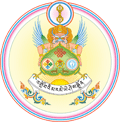Letting the Mind Settle
A beginner's mind is often compared to a big waterfall with thoughts tumbling down like rushing water, but there's no need to get upset or frustrated. Through regular practice it will gradually settle, become as gentle as a quiet river, and finally as deep and peaceful as an ocean without waves.
We shouldn't get impatient or angry if our mind keeps wandering and we have to bring it back every second. Anyway, mind cannot be subdued by anger; it can only be tamed with love and kindness. We should not, in the name of meditation, punish or upset ourselves. We should treat our mind the way a very tolerant and loving mother would treat her naughty child. The child has so much energy that it jumps and messes around all the time and tries to run out of the room. The mother doesn't get upset or angry, she doesn't beat it up. She lets it play, but within the confines of one room. Slowly, the naughty child will use up all his or her energy and come to rest. We should also allow our mind to jump anywhere it wants to jump, but watch it constantly and bring it back every time, a million times if necessary. We should not be judgmental, get impatient, discouraged or angry, otherwise our meditation will become very tense, difficult and painful. We give total space to our mind and let it wear out its own energy.
If we experience the big waterfall and cannot control our mind, some breathing exercises might be quite good.Breathing is part of us. If you are a beginner you can close your eyes and use mental counting. With each in and out breath you count one. You count up to five, then start from the beginning again. We completely engage our mental activity in the breathing without thinking about anything else.
As we are now really trying to discipline our mind, it may react and reject it. If we try hard, we will become very tense and start complaining about headaches. Headaches come because we are getting too uptight. Mind has been able to do whatever it wanted for so long and now we are telling it to stay here quietly, so it gets angry.
If you start to get uptight while counting, stop counting and instead discuss with your mind: OK, now, I'm asking you nothing, so you have no good reason to complain. We can discuss like this because we are talking all the time in our head in much the same way, and we really have to find ways and means to make our mind understand why we are doing what we are doing.
Sometimes people want a lot of information and, accordingly, Lamas give them a lot of information, but I think this may create obstacles. If people asked less, I would give them less information and they would have a simple meditation. This would be the best. As far as Mahamudra is concerned, the great Indian Master Tilopa put it very simply: Don't speak, don't think, don't meditate! So simple! I am following this tradition but find myself giving students a hundred different methods! Students meditate and then come to me, Lama Yeshe, this breathing technique is not working for me, it's giving me a hard time. I then explain to them how to focus on an object. Then they look at it and it gets strange, changing form and colour.
If we become very rigid in our meditation or put too much effort into it, we will get these kinds of hallucinations. When this happens, we should stop focusing on the object and just relax. We should apply effort very gently. So, when this happens, they come to me again and say Lama Yeshe, this is driving me crazy, please give me another method. And I give them something else.
This is why we live in a world of abundant methods - because there are abundant needs and wants. People keep asking me for different methods and I keep giving them what they ask for, because that's the only way we can have some communication going on, but in the end, the same people complain, I don't like Tibetan Buddhism because it is so complicated. Why do we have to do all this? But I never asked them to do all this. I always taught them how to be simple. I told them from the very beginning that it must be simple.
So, to start with, make no complications, just sit at ease, completely relaxed physically and mentally. Do not engage in past or future, do not even count your breathing. Just do nothing.
Reference: excerpt from 'Living Dharma' by Lama Yeshe Losal Rinpoche

